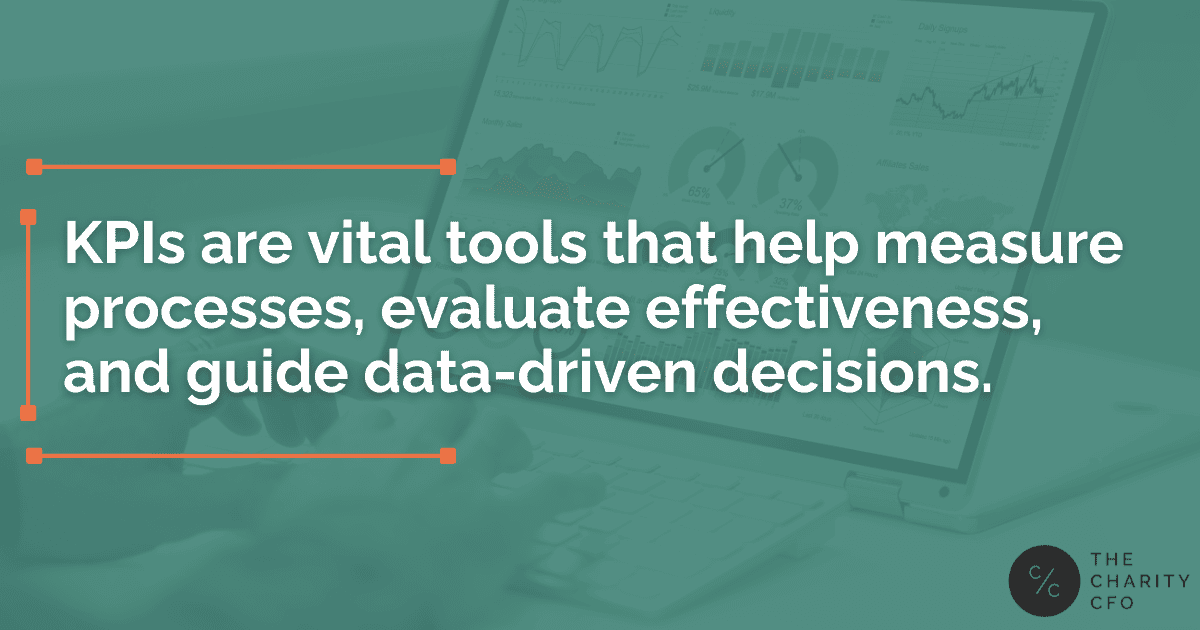KPIs You Should Be Tracking in a Nonprofit
Successful nonprofits and for-profit businesses alike use a variety of key performance indicators (KPIs) to help track their organization’s performance.
This guide will explore some of the most common nonprofit KPIs–including how to calculate them–to help you pick the right KPIs for your nonprofit.

Understanding the Importance of Nonprofit KPIs
KPIs are vital tools that help measure processes, evaluate effectiveness, and guide data-driven decisions. Tracking specific metrics helps nonprofits see how well they’re doing in areas such as:
- Fundraising
- Marketing
- Program delivery
- Operational efficiency
- Overall impact
In turn, KPI data helps leaders make informed decisions, optimize resources, and build trust and accountability with donors and stakeholders.
Financial KPIs
Financial sustainability is one of the most common challenges facing nonprofit organizations. Nonprofits need a way to track financial data that helps them increase revenue and lower expenses.
That’s where financial KPIs come in. Nonprofit organizations can use financial KPIs to get a better picture of their organization’s financial health and create strategies to maximize financial efficiency.
Revenue Growth Rate
- Revenue growth rate formula: (Current period revenue – previous period revenue) / previous period revenue X 100
The revenue growth rate of a nonprofit is the percentage increase or decrease in revenue over a specified period. This essential KPI is one of the most important financial metrics your organization can use to track growth and financial sustainability.
Your organization’s revenue growth rate can either be a positive or negative percentage. Positive growth rates indicate a growing or sustainable organization. If you have a positive growth rate, you know your organization was able to attract more funding than before.
Revenue Growth Rate Example
An organization’s revenue for the previous year was $100,000. Their current-year revenue is $120,000. Using the revenue growth rate formula, this organization’s growth rate is 20%.
Leaders can use this information to determine if the organization is ready to expand resources, such as hiring more staff or expanding program services.
Days of Cash on Hand
- Days of cash on hand: (Average daily operating expenses) / (Current cash and cash equivalents)
This represents the number of days an organization can operate without additional cash flow.
We recommend that an organization maintain 90-120 days of cash but no fewer than 30 days.
Unrestricted Revenue
Unrestricted revenue for nonprofits refers to funds not limited by donors for specific purposes. Your organization is free to allocate these resources wherever they are needed.
This type of revenue provides flexibility in managing operational expenses, program development, and other essential activities.
We recommend that at least 50% of an organization’s revenue come from unrestricted sources.
Operating Reserve Ratio
- Operating Reserve Ratio: (Annual operating expenses) / (Operating reserves)
This ratio demonstrates for what percentage of the year an organization can sustain itself without additional funding. We recommend that an organization maintain at least 25% of operating reserves.
Current Ratio
- Current ratio: (Current assets) / (Current liabilities)
The current ratio shows how well an organization can meet its short-term obligations with its short-term assets. It’s a good indicator of liquidity and financial health.
We recommend that an organization maintain a current ratio of at least 1, indicating that it can cover its short-term obligations with its most liquid assets.
Diversification of Revenue
Diversification of revenue means reducing dependency on a single fundraising stream by generating income from a variety of sources, such as:
- Grants
- Donations
- Fundraising events
- Service fees
This strategy enhances financial stability and sustainability by mitigating the risk of income loss from any one source.
We recommend that no more than 15% of an organization’s total revenue come from the same funder or customer. Maintaining higher cash reserves can mitigate the risk associated with high revenue concentrations.
Long-Term Reserves
Long-term reserves are funds set aside to ensure the organization’s financial stability and sustainability over an extended period. These reserves are typically invested and can be used for future needs, capital projects, or to address unforeseen financial challenges, providing a safety net for the organization’s continued operations and mission fulfillment.
When an organization achieves more than 120 days of cash on hand, it should consider investing excess cash reserves to yield additional income. The board may choose to designate these funds for specific purposes and/or develop an investment policy that aligns with long-term goals.
Fundraising Efficiency Ratio
- Fundraising efficiency ratio formula: (Fundraising expenses / Total funds raised) X 100
The fundraising efficiency ratio helps determine the sustainability and value of specific fundraising efforts.
Your fundraising efficiency ratio can help make decisions regarding resource allocation to maximize revenue and optimize expenses. The higher the ratio percentage, the less efficient a fundraising effort.
Fundraising Efficiency Ratio Example
A nonprofit hosts two major fundraising events per year. The first event costs $10,000 and raises $100,000 in donations. The second event costs the organization $50,000 and raises $250,000. The first event’s fundraising efficiency ratio is 10% while the second event’s is 20%.
Although the first event raises less money, it’s a more efficient use of resources.
Program Expense Ratio
- Program expense ratio formula: (Program expenses / total expenses) X 100
The program expense ratio compares the cost of running nonprofit programs to the total cost of running the organization. Your organization can use the program expense ratio to compare program costs with other organizational costs, such as administrative or fundraising expenses. Tracking program expense ratios show how much of your resources go directly to your mission via programs and services.
In addition, the program expense ratio can help you determine the efficiency of your nonprofit program and services. This helps you see how efficiently your organization uses resources when delivering on your mission.
Program Expense Ratio Example
A nonprofit’s total annual expenses are $100,000 and its program expenses are $80,000. This means the organization has a program expense ratio of 80%. A higher program expense ratio shows an organization that dedicates a large portion of its resources to advancing its mission.
Operational and Fundraising KPIs
Efficient operational processes can help a nonprofit organization cut expenses and maximize revenue. Operational KPIs track metrics related to your operational expenses and resource allocation. You can use operational KPIs to improve the efficiency of how your organization runs.
Donor Retention Rate
- Donor retention rate formula: [(Number of donors at the end of the period – number of new donors) / number of donors at the beginning of the period] X 100
The donor retention rate is the percentage of donors who continue to support your organization after a specified period. Donor retention rates help keep track of repeat donors, which can be a good indicator of donor satisfaction.
Tracking donor retention rates can help you determine if your donor outreach and communications are working to create repeat donors. The higher your retention rate, the more likely you are to have a sustainable donation pipeline from repeat donors.
Donor Retention Rate Example
Your organization starts the year with 500 donors and gains 100 new donors over the year. At the end of the year, you have 450 active donors. Your donor retention rate would be 70%, which could be a sign of effective donor engagement strategies.
Fundraising Efficiency Ratio
- Fundraising Efficiency: [(Cost of fundraising) / (Net revenue from fundraising)] ×100
This measures the financial efficiency of your fundraising efforts by comparing the net revenue to the costs. You can use it to assess how effective your fundraising activities are and help you make future investment decisions that will maximize impact.
Remember: a higher efficiency means the campaign is raising significantly more money than it costs – this is great!
Administrative Overhead Ratio
- Administrative overhead ratio formula: (Administrative expenses / total expenses) X 100
Your organization’s administrative overhead ratio gives insights into how efficiently your organization allocates resources. An organization that spends a significant portion of its resources on administrative costs may not put enough resources into program delivery and other mission-related activities.
Keeping administrative overhead ratios low shows financial transparency and responsibility to stakeholders and donors.
Administrative Overhead Ratio Example
A nonprofit’s administrative expenses are $60,000 and total expenses are $100,000. This means the organization uses 60% of its resources on administrative costs, which could indicate operational inefficiencies.
Volunteer Engagement
- Volunteer engagement rate formula: Number of volunteer hours contributed OR the number of volunteers actively engaged
The volunteer engagement rate is a great indicator of volunteer participation in your organization. It lets you track volunteer engagement over time to see if your outreach is working to retain volunteers in a scarce environment.
High levels of volunteer engagement may show that the community supports your organization’s mission. They can also indicate an effective volunteer management program.
Volunteer Engagement Rate Example
Your nonprofit has 50 volunteers who collectively contribute 500 hours of service to your organization a month. Over time, you notice the rate drops to 40 volunteers who contribute 300 hours of service. This could be a sign that your volunteer management practices aren’t as effective as before.
Programmatic KPIs
Programmatic KPIs measure the performance of your nonprofit’s programs for your community. These metrics help you get a better idea of the effectiveness and efficiency of your programs and services.
Number of Beneficiaries Served
- Beneficiaries served formula: Count the unique beneficiaries in a timeframe
The number of beneficiaries served metrics helps your organization determine the direct impact in your community. As you increase the number of people your programs serve, you show stakeholders, donors, and community members the benefits of your organization.
This metric also helps you see the reach and scale of your programs and services within your community.
Number of Beneficiaries Served Example
A nonprofit provides educational programs to 500 students in a year. The next year, the program served 550 students, increasing the program by 50 beneficiaries.
Cost Per Beneficiary Served
- Cost per beneficiary served: (Total program costs) / (Number of beneficiaries served)
This measures the average expense incurred to provide services or support to each individual beneficiary. It’s a great metric for organizations to determine the efficiency and impact of their spending.
Program Success Rate
- Program success rate formula: (Number of program objectives reached / total program objectives) X 100
The program success rate measures how many program objectives or goals your organization completes during a project. This is a great internal metric you can use to determine your organization’s ability to set and meet intended outcomes.
Nonprofit leaders can also use the program success rate to assess the efficiency and effectiveness of program implementation. You can use this data to help guide improvements to future projects.
Program Success Rate Example
A nonprofit sets ten objectives for its latest community development project and successfully achieves eight. The program’s success rate is 80%, meaning the program met most of its intended goals.
Selecting and Implementing KPIs for Your Nonprofit
These KPIs can help your nonprofit start tracking the performance of your organization–from financial health to program efficiency.
Need help getting started? The team at the Charity CFO is here to help you design a financial KPI strategy for your organization.
Learn more about selecting and implementing nonprofit KPIs by scheduling a call with us today.








